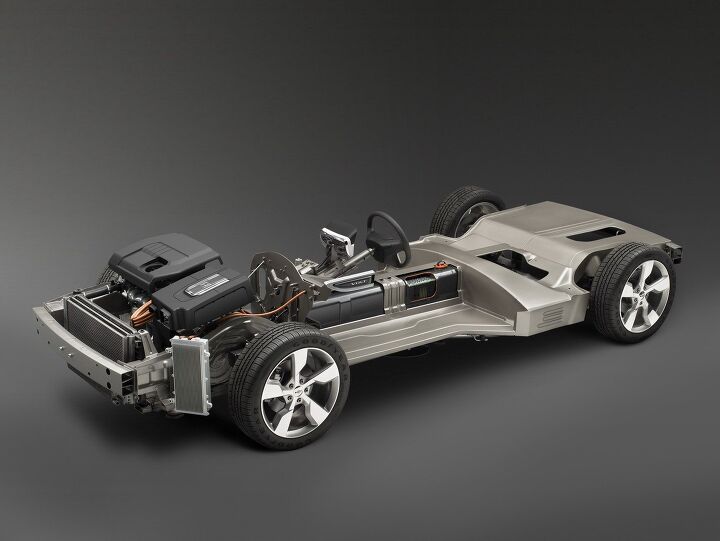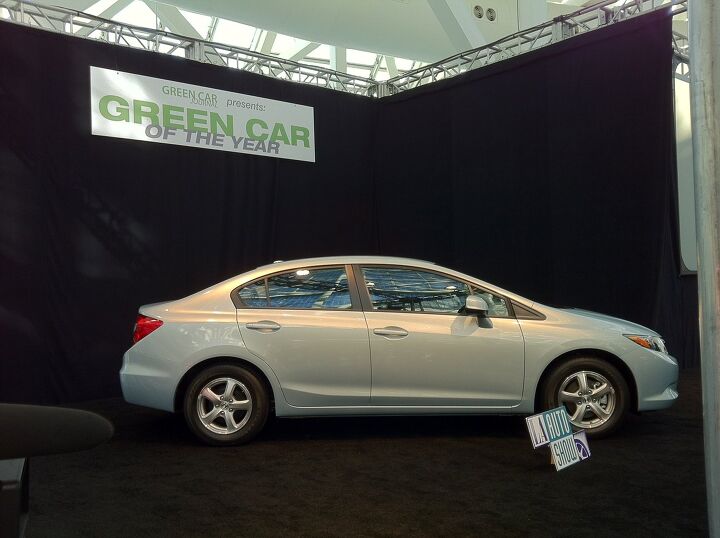#EV
Data Of The Day: An Interactive Map Showing EV/Hybrid Sales By Location
Everyone knows TTAC hearts data, so this little NPR/Edmunds collaboration, which maps hybrid and EV sales by locality, is right up our HOV lane.
LA Auto Show: Coda Electric Sedan
Volkswagen Goes Postal, Develops The Electric "Fridolin" Of The Future
Are you familiar with the Fridolin? If so, hit the jump. If not, here’s the brief version of its history. Unhappy with its adorable but inadequate, two-cylinder Goggomobil Transporters, the German Postal Service approached Volkswagen and Westfalia in the early 60s, looking for a new interpretation of what it was looking for, namely “arbeitspsychologisch optimaler Ausstattung zu einem günstigen Anschaffungspreis.” This is a tough phrase to translate, but essentially it means “equipment optimized for the workplace psychology, at an affordable price,” and in 1963 that’s what the VW-Westalia team delivered. A mixture of Type 1 (Beetle), Type 2 (Bus) and Type 3 (Fastback/Squareback), the Type 147 was first shown to the German Post in 1963, and was quickly nicknamed “Fridolin” (an uncommon German boy’s name) apparently because workers said “it looks like a Fridolin.” Only 6,126 were built between 1964 and 1973, and they continue to enjoy a strong collector’s cachet ( primarily as slammed campers, apparently). And now, Volkswagen wants to re-create the classic… for the future.
About Those Chevy Volt Safety Protocols…
I caught hell from a number of TTAC’s Best and Brightest five days ago, when I blogged about the Chevrolet Volt fire at a NHTSA facility but failed to initially note GM’s response. At the time, GM’s Greg Martin said
GM has safety procedures for handling the Volt and its battery after an accident. Had those been followed, there wouldn’t have been a fire.
At the time, a number of readers accused me of bias for not including Martin’s response at first. Eventually I conceded that this was some worthwhile perspective for the story, but I cautioned that it only represented the opinion of one GM employee. Whether or not NHTSA actually followed those procedures remained an open question… until now. Automotive News [sub] is reporting that NHTSA couldn’t possibly have followed those procedures, nor indeed could anyone else, for the simple reason that GM failed to share them with anybody. So not only is the NHTSA fire being blamed on the fact that government regulators were not given the necessary safety procedures, but it turns out that rescue workers, salvage yards, towing companies and the like were not taught how to discharge the Volt’s battery either. In other words, this NHTSA crash was an important eye-opener for the Volt team.
What The Foxtrot Is a Doking?
Honda Launches Fit EV, But Civic GX Takes Green Car Prize
Anwyl: Should We Be Preparing For The Next Gas Price… Collapse?
The big news around here yesterday came from Bertel’s interview with Toyota’s Chief Engineer, in which it became clear that Toyota takes the developing world’s growing demand for oil very seriously. With global demand already outstripping supply, the giant automaker’s embrace of a petroleum-constrained business model seems to make it clear that gas prices will play a significant role in the future. But markets are, by their natures, both difficult to predict, and shaped by predictions. And Edmunds CEO Jeremy Anwyl reckons that, although gas prices are high and could well go up in the short term, fears of a runaway gap between supply and demand may not materialize over the longer term. He writes:
Here’s the twist: As I said, the consensus belief (or story) on future oil prices is that they will be higher. And short term, this may be the case if and/or when the global economy recovers and/or demand grows in emerging markets.
But there is a longer-term story as well. This story suggests that peak oil may be nigh and the future holds shortages and sharply higher prices. Buying into this story, companies, acting individually, will see profit in expanding exploration, developing sophisticated new extraction technologies, etc.
The aggregate result of all these individual activities is that the future supply of oil will improve and prices will actually drop.
In fact, we have seen this paradox play out before. Through the Seventies, we were first shocked by rapid price increases and then conditioned to believe they would continue. And, of course, oil prices collapsed in the Eighties.
In The Battle For The Post-Oil Auto, Big Investors Are Shooting The Moon
As Bertel pointed out earlier today, peak oil is here: the graph above is not from some fly-by-night EV firm, but Toyota, an auto industry giant. What years of environmental and security arguments failed to communicate, economics is now explaining with little difficulty. Namely, that demand for oil is growing faster than supply, forcing developed economies to look beyond oil for future growth. And, as you might expect from a conservative player in a conservative industry, Toyota argues that the solution to this growing disconnect is a portfolio of drivetrain technologies. But what if, instead of trying to adapt an existing business model to the new oil reality, you built a new business model from the ground up? That’s exactly what Project Better Place is trying to do, and the contrast between its approach and that of Toyota is fascinating to anyone interested in the future of the automobile.
Chart Of The Day: The Truth About Vehicle Fires Edition
I’ve suggested in these pages that the several documented fires involving Chevrolet Volts suggest some kind of pattern, as no other major-manufacturer EVs have been involved in any reported fires. But, as Ronnie Schreiber at Cars In Depth points out, even that pattern seems to pale in comparison to the National Fire Protection Association’s tally of highway vehicle fires in the US each year. Though the number of highway vehicle fires has decreased significantly since 1980, 2009 still saw 190,500 fires. And between 2003 and 2007,
On average, 31 highway vehicle fires were reported per hour. These fires killed one person a day.
Chevy Volt Catches Fire After Crash Test, Investigation Under Way
The Chevy Volt fire rumors started early this week, when the utility company Duke Energy told its customers to stop using their Chevy Volt home chargers after an October 30 fire. At last word, NHTSA said that
No conclusions have yet been reached regarding the cause of the fire. We are continuing to monitor the situation.
But it seems that the investigation is coming home, as Bloomberg just reported that a Chevy Volt caught fire at a NHTSA facility, shortly weeks after being crash tested.
The Volt caught fire while parked at a National Highway Traffic Safety Administration testing center in Wisconsin, three weeks after a side-impact crash test, said an agency official. The official, as well as the three other people familiar with the inquiry, said they couldn’t be named because the investigation isn’t public.
The fire was severe enough to burn vehicles parked near the Volt, the agency official said. Investigators determined the battery was the source of the fire, the official said.
Ruh-Roh!
Smyrna And The Solyndra Problem
Ever since the messy collapse of solar panel maker Solyndra just two years after it received over half a billion dollars in government loans, the political climate around all green energy loan programs has heated up considerably. As the White House opened an investigation of the Department of Energy’s entire loan portfolio, loan recipients and startup automakers Tesla and Fisker found themselves under attack. And why not? Fledging firms with unproven products in brutal, scale-driven industries are hardly safe bets, even in the best of times. And with the government drowning in deficits, who’s in a gambling mood?
What gets left out in the hue and cry is that Tesla and Fisker between them represent “only” about a billion dollars worth of DOE loans in a program that was supposed to be able to loan out $25b (the final tally could be closer to $18b). Dwarfing the half-billion-each investments in Fisker, Tesla, and Solyndra are projects that seem a lot less risky in contrast to the startups. Here, in Smyrna, TN, I got to see one of them being built.
Volt Production Drops Slightly As Export Volume Ramps Up And Dealers Sell Demonstrators
With all the attention being paid to Volt sales, production and turn time in the wake of recent congressional criticism, I thought I’d update our recent chart of Volt sales versus production to see how GM’s wonder car is doing a month on. As you can see, there’s not much obvious change on the year-to-date chart, with both sales and production trending upwards. But if we zoom in on the most recent months, we can see something strange happening…
And You Thought The Ford Focus Titanium Was Expensive
Musk Sees Tesla Profit In 2013, But Losses (And Issues) Are Still Piling Up
According to Tesla CEO Elon Musk, the EV luxury brand has pre-sold all 6,500 units of its new Model S to be built next year, and the company is on-track for a 2013 profit. Bt if you’re comparing Tesla to the erstwhile EV darling BYD in order for it to look good, you have to wonder how good things really are. If anything, Tesla should be compared to Audi, an established (and hot) luxury brand with the same EV technology and one of Tesla’s founders on board. Losses for this fiscal year are estimated at $437m, and Tesla’s crucial loans from the Department of Energy are attracting a distracting investigation in the wake of the Solyndra scandal (but hey, Musk is “personally guaranteeing” those loans, so no worries…). And, in a truly puzzling move, Tesla is ignoring the SAE J1772 protocol for rapid EV charging because it isn’t sexy looking enough. As EV guru Chelsea Sexton puts it to the New York Times
It’s hardly unusual for Tesla to zig where the rest of the industry zags. But it’s particularly counterintuitive not to use the J1772 standard, since Model S drivers will be more interested in public charging than Roadster owners. Tesla’s proprietary connector choice requires getting customers to care about form over function on one of the most utilitarian aspects of the car. How many people stare at a gas nozzle and think, ‘If only that were better looking’?
Selling out of a first-year production run is good news, but hardly surprising (all plug-in vehicles are currently capacity-constrained). Preventing buyers from using public charging infrastructure because it’s unsexy is the kind of surprising news that could seriously damage Tesla’s long-term efforts. Meanwhile, we still don’t know how this company will do with regards to manufacturing quality and reliability, especially as volumes ramp up to 20k units per year. After all, Tesla’s hype and niche marketing efforts are well-proven… it’s all the other aspects of building and selling cars that we’re still unsure about.
Why The Government Should Have Stayed Away From Fisker And Tesla
The Detroit News reports that the White House has ordered a review of the Department of Energy’s various loan programs in the wake of the Solyndra scandal, noting
White House Chief of Staff William Daley ordered an independent analysis on the state of the Department of Energy’s loan portfolio — including loans to solar, nuclear and auto companies.
“The president is committed to investing in clean energy because he understands that the jobs developing and manufacturing these technologies will either be created here or in other countries,” Daley said.
One of those programs is the so-called “Advanced Technology Vehicle Manufacturing” loan program, which was nearly used to fund the Detroit bailout and has since come under fire from various quarters. Twice already the Government Accountability Office has questioned the ATVM loan program for its lax oversight, weak goals, lack of technical support, inconsistency in awarding loans and the undetermined impact of funded vehicles. And those internal issues could help explain why the Center For Public Integrity has accused the ATVM program of operating a patronage scheme, alleging that major Obama donor and Tesla board member Steve Westly personally benefitted from loans made to the company. And on the Fisker side of things, backer John Doerr of the VC firm KleinerPerkins is another major Obama donor, suggesting a pattern of politically-motivated loan awards to well-connected EV firms that carry high risks. With government intervention in the auto industry still a hot-button issue in the wake of the bailout, this scandal has huge implications for the legitimacy of America’s emerging “industrial policy.”
























Recent Comments